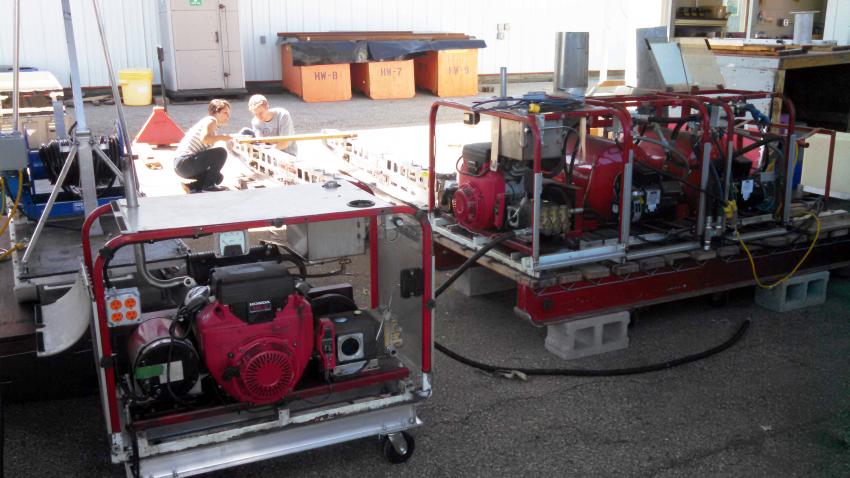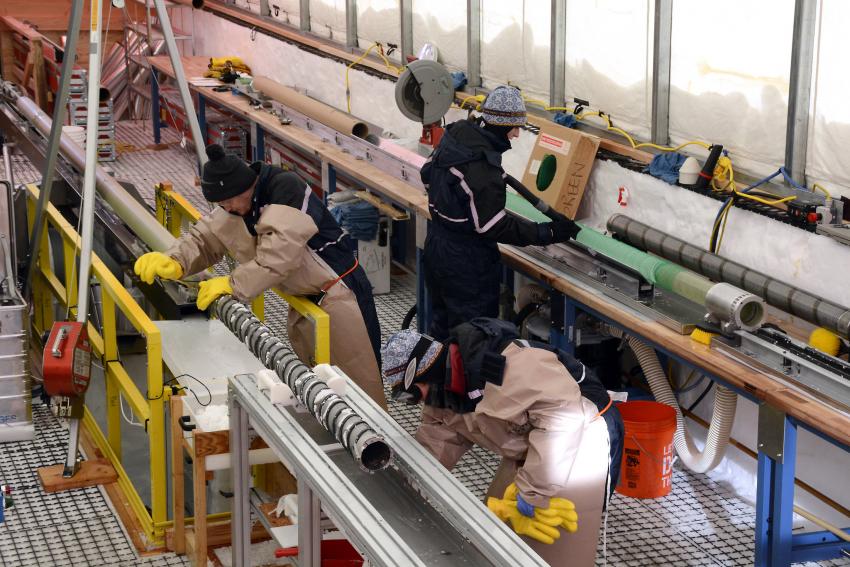Based on excellent feedback from the Principal Investigators (PIs) and science teams who frequently use the IDDO Small Hot Water Drills (SHWD) for seismic work, IDDO worked during the Third Quarter (May 1, 2015 - July 31, 2015) to implement several beneficial upgrades to the system, including new fittings, hose, a new nozzle and added safety features in addition to maintenance of the heaters and power unit. Working closely with engineers and summer students at the UW Physical Sciences Lab (PSL) in Stoughton, WI, IDDO has benefitted from the wealth of hot water drilling knowledge located there, as several of the engineers at PSL participated in the design and operation of the Enhanced Hot Water Drill used for the IceCube project. This synergistic relationship is expected to continue, as IDDO looks toward another tier of upgrades to the SHWD in PY 2016 (November 1, 2015 - October 31, 2016). The system pictured below will be shipped to Antarctica in September and used by PIs Howard Conway and Paul Winberry to create shot holes for seismic work to investigate the grounding line dynamics of the Crary Ice Rise.
Beneficial, User-Identified Upgrades Made to IDDO Small Hot Water Drill
- Small Hot Water Drill
IDPO Launches New Course Targeting Professors at Minority-Serving Institutions
- Education/ Outreach
In June 2015, twelve nationally selected college professors from Minority-Serving Institutions attended the first in-depth "School of Ice" in Denver, Colorado. A Leadership Team including Lockheed's Antarctic Support Contract, Polar Field Services, the National Ice Core Laboratory (NICL), and the Institute of Arctic and Alpine Research contributed to the packed four-day agenda, which highlighted the latest scientific and engineering content via live and virtual presentations from ice drilling and coring scientists and engineers. Among those who contributed content were Joe McConnell, Ed Brook, Sarah Das, Bruce Vaughn, Bob Anderson, NSIDC's Ted Scambos, Gary Clow, Jay Johnson, Seth Campbell, Laurel McFadden, Ashley Maloney, Jeff Severinghaus and Linda Morris. Evaluation of the workshop showed evidence of statistically significant increases in the professors' scientific and engineering background knowledge and pedagogical ability to instruct their students. Created by IDPO, the project was the result of a partnership with the American Meteorological Society. The initial program was highlighted in an article by the Antarctic Sun (see Empowering Educators at the School of Ice: U.S. Ice Drilling Program Office Offers Educators a Close-Up Look at Ice Core Science), and plans are underway for expanding its reach through a 2016 event. Funding was provided to IDPO by Lockheed Martin through a proposal written by Linda Morris.
Acknowledgement of IDPO-IDDO in Publications (2015 Summer)
- Publications
If you receive any support from IDPO-IDDO, we kindly request that you credit IDPO-IDDO in any resultant publications or articles with the following statement: "We thank the Ice Drilling Program Office and Ice Drilling Design and Operations group for coring activities (NSF-1327315)." If you have any questions regarding crediting IDPO-IDDO, please contact us at icedrill@dartmouth.edu .
Scientific Field Support (2015 Summer)
- Fieldwork
The Third Quarter (May 1, 2015 - July 31, 2015) saw the 2015 Arctic season come to a close and preparations ramp up for the approaching 2015-2016 Antarctic season. IDDO received the remainder of its equipment back from Greenland and worked to complete repairs and modifications. Equipment will begin shipping to Antarctica early in the Fourth Quarter.
Equipment Development (2015 Summer)
- Agile Sub-Ice Geological Drill
- Intermediate Depth Drill (IDD)
- Blue Ice Drill (BID)
- Winkie Drill
Agile Sub-Ice Geological Drill
Purchasing efforts ramped up for the Agile Sub-Ice Geological (ASIG) Drill project. A web/teleconference review of the Integrated Detailed Final Design was held on May 28, 2015 with participation from IDPO, IDDO and SSEC engineers and several experts and colleagues from various drilling industries. Project Manager Chris Gibson worked with the manufacturer of the base rig (Multi-Power Products Ltd. in British Columbia, Canada) to resolve issues identified in Madison during initial Acceptance Testing. The manufacturer has subsequently completed all rework of system components that did not originally meet the weight specifications outlined in the contract. Planning efforts have increased for the upcoming test of the drill's packer device (for sealing the borehole casing to non-porous ice) near McMurdo Station during February 2016, and for the larger-scale ASIG Drill system test planned in Madison, WI, during the upcoming winter.
Intermediate Depth Drill
Preparation is well underway for the second production season of the SPICEcore project at the South Pole. A new drill motor was purchased to replace one that sustained damage during the 2014-2015 field season. Work was performed to repair, standardize and test all circuit boards in the control system. Maintenance and repairs were initiated for the chip chamber, chip valve, hollow shaft assembly, pump and anti-torque slip sensor. Repair of the tower pendant was completed, with the addition of Teflon cabling for durability during contact with drill fluid. A power meter was also specified and parts for it were ordered. IDDO plans to ship all repaired and modified Intermediate Depth Drill equipment back to the South Pole in mid-September.
Blue Ice Drill – Deep
Engineers monitored the progress of new cutters deployed for testing in Greenland, in an effort to improve Blue Ice Drill – Deep (BID–Deep) core quality. The drill was able to drill to approximately 155 meters using the new step cutters and trying a variety of other techniques before core quality was no longer acceptable. This is approximately 15 meters deeper than the prior year, but still short of the initial 200 meter depth goal. Interactions with the IDPO Science Advisory Board will determine if additional efforts should be made for quality core at greater depths.
Winkie Drill
IDDO received approval from IDPO to pursue purchase of a commercially available Winkie Drill from Minex. Following telecons with IDPO, NSF and Ohio Range project PIs Robert Ackert and Sujoy Mukhopadhyay, IDPO-IDDO determined purchase of this new rock coring drill would better serve the needs of the Ohio Range project to obtain rock samples from the ice-bedrock interface, and the larger community, as opposed to making repairs and modifications to the Koci Drill. The new Winkie Drill is also expected to prove useful for the joint RAID/ASIG auger and packer tests near McMurdo in February 2016. Necessary purchase orders have been submitted. Upon receipt of the rig, IDDO will make modifications to the Winkie Drill to expand its capabilities to include augering and coring through ice.
2015-2025 Long Range Science and Long Range Drilling Technology Plans Updated
- Long Range Plans
- Science Advisory Board
The IDPO Science Advisory Board, IDPO, IDDO, and the science community, under Mary Albert's leadership, updated the IDPO Long Range Science Plan. The purpose of the Long Range Science Plan is to articulate goals and make recommendations for the direction for U.S. ice coring and drilling science, and for the development of drilling technology, infrastructure and logistical support needed to enable the science. The companion Long Range Drilling Technology Plan, updated by IDDO, identifies the drills and technologies needed to successfully implement the science in the Long Range Science Plan. Both plans are revisited and revised as appropriate each spring.
APECS IDPO Webinar
- Education/ Outreach
Mary Albert gave an invited webinar to the Association of Early Polar Career Scientists (APECS) discussing: ways in which early career researchers can participate in both short term and long term science planning for science endeavors requiring ice coring or drilling; how to request ice drilling support from IDPO-IDDO; and education and outreach activities that IDPO offers for community scientists. The webinar is archived on the APECS website at https://www.apecs.is/career-resources/webinars/webinar-archive/details/10/120.html .
Ice Core Working Group Virtual Meeting
- Meetings/ Workshops
- Science Advisory Board
- Ice Core Working Group
On May 21, 2015, IDPO's Ice Core Working Group (ICWC) held a virtual meeting in which it discussed current and upcoming ice coring issues, and reviewed and approved the prioritization of the drilling technology projects that the IDPO Science Advisory Board had recommended. The meeting was led by ICWG Chair Karl Kreutz.
Borehole Logging Working Group Presentation
- Meetings/ Workshops
- Science Advisory Board
On July 1, 2015, IDPO presented a webinar to the Borehole Logging Working Group (BLWG) on innovations in borehole logging techniques used in industry. Bill Eustes led the workshop.




